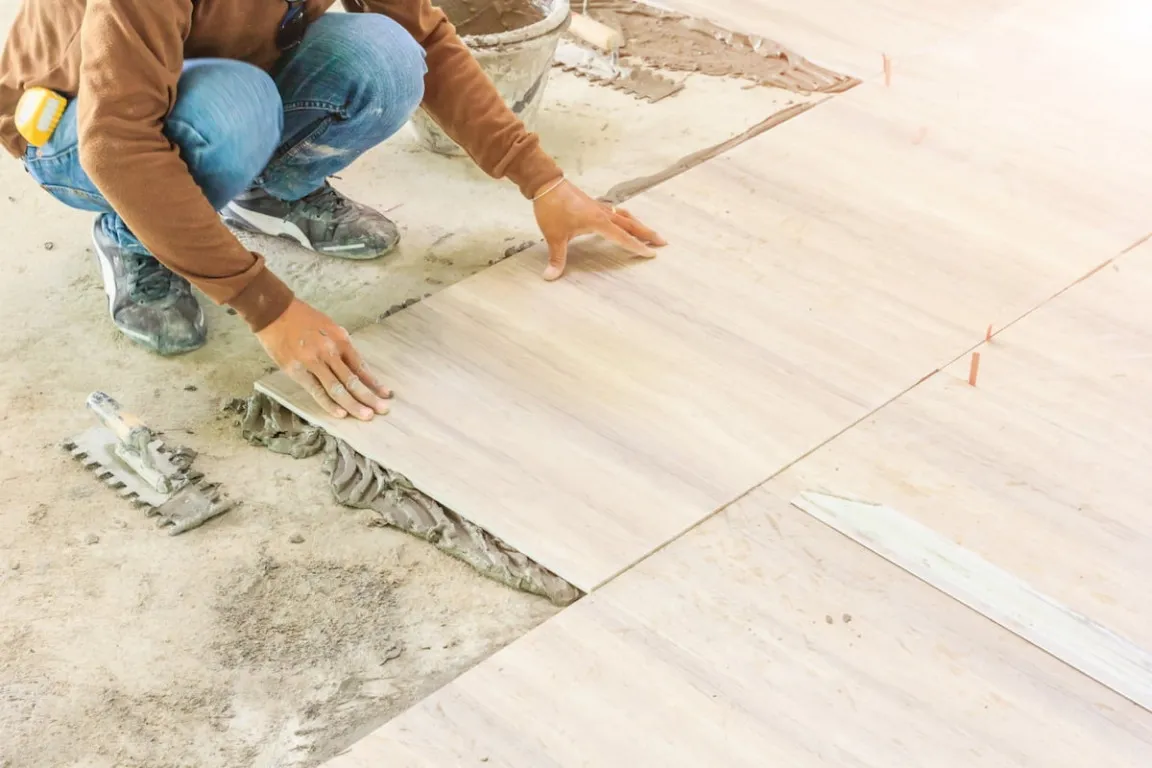Installing floor tiles is one way to enhance the aesthetics and durability of your home's flooring. Besides improving the appearance of the floor to be more attractive, the right tile installation technique will also determine the longevity of the floor.
So, how do you properly install floor tiles? This article will comprehensively discuss the steps for installing floor tiles in detail, from determining the starting point for cementing the floor to completion. Let's take a look!
Preparation Before Installing Floor Tiles
Before starting the tile installation, there are several things that need to be prepared to ensure the process runs smoothly and the achieve the best results. Here are some preparations you need to make:
1. Preparing the Surface for Tile Installation
Before installing tiles, ensure that the floor surface is clean, even, and dry. If there are cracks or holes, they should be repaired first. An uneven floor surface can cause tiles to crack or fail to adhere properly.
2. Installing Tiles Yourself or Hiring a Professional
If you have the time and skills, installing tiles yourself can be a cost-effective option. However, if you want neater and faster results, you can consider hiring a professional tile installation service per square meter. Make sure to choose a trusted service with a good license and portfolio.
3. Preparing the Right Materials and Tools
Before starting the installation, ensure all the necessary materials and tools are available. Some essential materials include floor tiles, cement, sand, and tile grout.
For tools, you will typically need a measuring tape, string, a trowel, a grinder as a tile-cutting tool, and a bucket for mixing the cement.
Read also: How to Calculate Ceramic Needs & Tips for the Right Choice
How to Determine the Starting Point for Floor Tile Installation
Determining the starting point for tile installation is crucial to ensure a symmetrical and aesthetically pleasing result. Additionally, this step helps you avoid uneven tile cutting along the edges of the room.
Here’s how to determine the starting point for floor tile installation:
1. Find the Center of the Room
Use a measuring tape to measure the length and width of the room. Find the center point by drawing diagonal lines from corner to corner. By determining the center of the room, you can start installing the tiles from a strategic area.
2. Measure the Room
After identifying the center point, re-measure the room to ensure the tiles are installed proportionally. Use a measuring tape to accurately measure the length and width of the floor. Multiply these measurements to get the total area in square meters.
For example, if the floor length is 10 meters and the width is 5 meters, the area is 50 square meters. For irregularly shaped floors, divide the space into simple sections and calculate the area of each part separately.
3. Start from the Center of the Room
Next, begin installing the tiles from the center of the room. This ensures symmetrical placement and prevents uneven tile cutting at the edges. Starting from the center also allows you to adjust the tile sizes at the edges more precisely.
Steps for Installing Floor Tiles
Once you have determined the starting point for tile installation, you can proceed with laying the tiles. Here’s how to install floor tiles:
1. Level the Floor Area
Ensure that the floor surface is perfectly level before starting the installation. As a tip, you can use a mixture of cement and sand to level uneven areas. Although it may seem trivial, a level surface helps the tiles adhere properly and prevents cracking.
2. Choosing the Right Tiles
Selecting the right tiles for your needs and room design is equally important. Make sure the tiles have guaranteed quality for long-lasting durability. Also, consider the size and pattern of the tiles to create a harmonious look.
For small rooms, large tiles can make the space appear more expansive. Meanwhile, smaller tiles are better suited for spaces that require intricate details. Additionally, choose tiles based on their function.
For example, opt for anti-slip tiles for areas frequently exposed to water, such as bathrooms or kitchens.
3. Soaking the Tiles
Before installation, tiles need to be soaked in water first. Submerge the tiles in a container filled with water, such as a basin or large tub. This process allows the tile pores to absorb water, making them more flexible and ensuring strong adhesion when installed.
4. Setting Up Guide Strings
After preparing the floor surface, the next step is to install guide strings along the edges and center of the floor. The purpose is to ensure the tiles are installed evenly and prevent misalignment or uneven surfaces.
Ensure the strings are straight and not slanted, as they will serve as the primary reference when installing tiles. With precise string guides, you can avoid installation mistakes that may ruin the floor's appearance.
5. Making the Cement Mixture
One of the most critical aspects of tile installation is preparing the right cement mixture. Mix cement with sand and water in the ideal ratio of 1 part cement to 3 parts sand.
Ensure the mixture is neither too runny nor too thick. A mixture that is too watery reduces adhesion strength, while a mixture that is too thick makes installation difficult.
Read also: How to Calculate Cement Requirements: Here’s the Guide
6. Start Installing Tiles from the Starting Point
The next step is to begin laying the tiles from the predetermined starting point. Then, gently press the tiles into the cement and ensure the tile grout spacing is consistent. Use a tile cutter to adjust tile sizes at the edges.
7. Let It Dry for 24 Hours
After all the tiles are installed, let the floor dry for at least 24 hours before stepping or placing heavy objects on it. This step ensures the tiles adhere perfectly and do not shift.
8. Apply Tile Grout
Once the tiles are completely dry, the next step is applying the grout. Mix the grout with water according to the instructions on the package, then apply it between the tiles using a special tool.
After application, clean any excess grout from the tile surface using a sponge or a special brush. Ensure the grout is completely dry before using the floor.
That is the guide on how to install floor tiles you can follow at home. Proper tile installation enhances both the aesthetic and durability of your home's flooring. With careful preparation, high-quality materials, and the right installation techniques, your tile installation will achieve optimal results.
However, floor strength depends not only on the installation technique but also on the quality of the materials used in the process. To ensure strong adhesion and long-lasting durability, choose Semen Merah Putih Watershield, equipped with water-repellent technology to protect floors from moisture and water damage.
Semen Merah Putih Watershield is a premium multi-purpose cement with superior advantages over regular cement. It is perfect for various building applications, such as foundations, concrete slabs, casting, brickwork, plastering, and finishing.
For more information about Semen Merah Putih Watershield and how it can improve the quality of your home's flooring, visit our website or contact us today!
Read also: 5 Causes and Ways to Overcome Damp Walls, Worth a Try!



